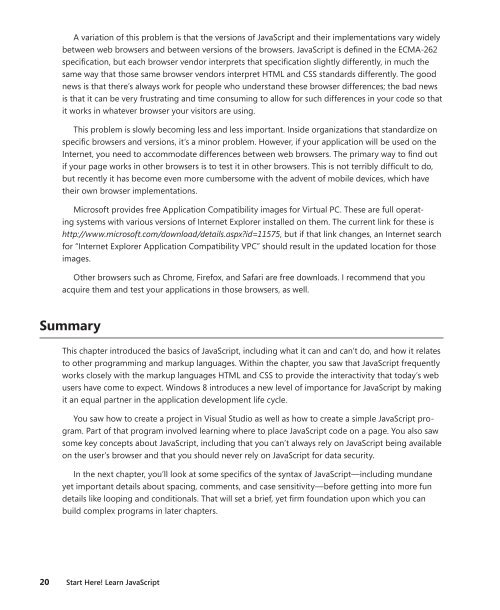Start Here! Learn JavaScript - Cdn.oreilly.com
Start Here! Learn JavaScript - Cdn.oreilly.com
Start Here! Learn JavaScript - Cdn.oreilly.com
You also want an ePaper? Increase the reach of your titles
YUMPU automatically turns print PDFs into web optimized ePapers that Google loves.
A variation of this problem is that the versions of <strong>JavaScript</strong> and their implementations vary widely<br />
between web browsers and between versions of the browsers. <strong>JavaScript</strong> is defined in the ECMA-262<br />
specification, but each browser vendor interprets that specification slightly differently, in much the<br />
same way that those same browser vendors interpret HTML and CSS standards differently. The good<br />
news is that there’s always work for people who understand these browser differences; the bad news<br />
is that it can be very frustrating and time consuming to allow for such differences in your code so that<br />
it works in whatever browser your visitors are using.<br />
This problem is slowly be<strong>com</strong>ing less and less important. Inside organizations that standardize on<br />
specific browsers and versions, it’s a minor problem. However, if your application will be used on the<br />
Internet, you need to ac<strong>com</strong>modate differences between web browsers. The primary way to find out<br />
if your page works in other browsers is to test it in other browsers. This is not terribly difficult to do,<br />
but recently it has be<strong>com</strong>e even more cumbersome with the advent of mobile devices, which have<br />
their own browser implementations.<br />
Microsoft provides free Application Compatibility images for Virtual PC. These are full operating<br />
systems with various versions of Internet Explorer installed on them. The current link for these is<br />
http://www.microsoft.<strong>com</strong>/download/details.aspx?id=11575, but if that link changes, an Internet search<br />
for “Internet Explorer Application Compatibility VPC” should result in the updated location for those<br />
images.<br />
Other browsers such as Chrome, Firefox, and Safari are free downloads. I re<strong>com</strong>mend that you<br />
acquire them and test your applications in those browsers, as well.<br />
Summary<br />
This chapter introduced the basics of <strong>JavaScript</strong>, including what it can and can’t do, and how it relates<br />
to other programming and markup languages. Within the chapter, you saw that <strong>JavaScript</strong> frequently<br />
works closely with the markup languages HTML and CSS to provide the interactivity that today’s web<br />
users have <strong>com</strong>e to expect. Windows 8 introduces a new level of importance for <strong>JavaScript</strong> by making<br />
it an equal partner in the application development life cycle.<br />
You saw how to create a project in Visual Studio as well as how to create a simple <strong>JavaScript</strong> program.<br />
Part of that program involved learning where to place <strong>JavaScript</strong> code on a page. You also saw<br />
some key concepts about <strong>JavaScript</strong>, including that you can’t always rely on <strong>JavaScript</strong> being available<br />
on the user’s browser and that you should never rely on <strong>JavaScript</strong> for data security.<br />
In the next chapter, you’ll look at some specifics of the syntax of <strong>JavaScript</strong>—including mundane<br />
yet important details about spacing, <strong>com</strong>ments, and case sensitivity—before getting into more fun<br />
details like looping and conditionals. That will set a brief, yet firm foundation upon which you can<br />
build <strong>com</strong>plex programs in later chapters.<br />
20 <strong>Start</strong> here! <strong>Learn</strong> <strong>JavaScript</strong>

















